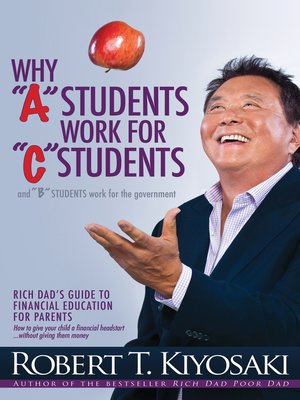Why "A" Students Work for "C" Students and Why "B" Students Work for the Government
ebook ∣ Rich Dad's Guide to Financial Education for Parents
By Robert T. Kiyosaki

Sign up to save your library
With an OverDrive account, you can save your favorite libraries for at-a-glance information about availability. Find out more about OverDrive accounts.
Find this title in Libby, the library reading app by OverDrive.



Search for a digital library with this title
Title found at these libraries:
| Loading... |
Kiyosaki expands on his belief that the school system was created to churn out 'Es' / Employees... those "A Students" who read well, memorize well and test well... and not the creative thinkers, visionaries and dreamers –entrepreneurs-in-the-making... those "C Students who grow up to be the innovators and creators of new ideas, businesses, applications and products.
The book urges parents not to be obsessed with their kids' "letter grades" ("good grades" might only mean they or the student themselves were successful in jamming a square peg into a round hole...) and focus, instead, on concepts, ideas, and helping their child find their true genius, their special gift. The path they can pursue with a love and true passion.
Robert showcases success stories of "C Students" who grew up to be phenomenal successes – and HIRED those "A Students"(attorneys, accountants, and other school-smart specialists) to work in their businesses... while the more average students, "B Students," often find themselves in government-type jobs...
Not surprisingly, Kiyosaki will coin his own definitions of what "A," "B," and "C" stand for as he gives parents and their children bits of wisdom as well as insights and tools for navigating an ever-changing world... an Information Age world where the ability to change and adapt, understand relationships, and anticipate the future will shape their lives.
The book urges parents not to be obsessed with their kids' "letter grades" ("good grades" might only mean they or the student themselves were successful in jamming a square peg into a round hole...) and focus, instead, on concepts, ideas, and helping their child find their true genius, their special gift. The path they can pursue with a love and true passion.
Robert showcases success stories of "C Students" who grew up to be phenomenal successes – and HIRED those "A Students"(attorneys, accountants, and other school-smart specialists) to work in their businesses... while the more average students, "B Students," often find themselves in government-type jobs...
Not surprisingly, Kiyosaki will coin his own definitions of what "A," "B," and "C" stand for as he gives parents and their children bits of wisdom as well as insights and tools for navigating an ever-changing world... an Information Age world where the ability to change and adapt, understand relationships, and anticipate the future will shape their lives.






